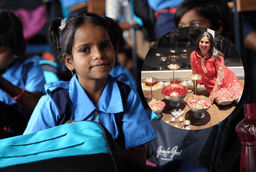

- 01 Nov 2023

What defines rural India? How is it that, despite 65% of India's population residing in rural areas, their development rate remains poor and often overlooked? These questions highlight a pressing issue that requires immediate attention. Rural India is a reservoir of untapped potential that, when leveraged, will reap benefits for the entire nation.
Under the shade of leafy trees and on the dusty grounds of government schools, young minds brim with potential. However, the journey from these humble beginnings to national recognition is often fraught with challenges. This is where an enhanced education system can make all the difference.
Let's explore how India can harness its rural talent by reimagining its education landscape.
How do we expect better education with no schools to go to? The first step in nurturing rural talent is to revamp the educational infrastructure. Many rural schools in India still struggle with dilapidated buildings, inadequate classrooms, and a severe lack of basic amenities like clean toilets. Students in these schools often sit on the floor in cramped classrooms. A modernized and well-equipped learning environment is the foundation on which talent can thrive. The government, corporate companies, and NGOs can step up to the plate by investing in building and renovating schools, providing clean drinking water, and constructing proper toilet facilities. Access to technology and up-to-date learning resources is also vital in today's digital age. By bridging the infrastructural gap, we can ensure that every child has an equal chance to unlock his/her potential.
Most rural schools have classrooms without teachers to teach. Absenteeism is a problem simply due to a lack of training, proper qualifications, and fair pay. Dedicated training facilities and mentorship programs nurture both students and educators. Teachers, responsible for a student’s future, deserve respectable pay and treatment. Non-profits across the country work towards establishing training centers where teachers can upgrade their skills, learn modern teaching methods, and adapt to changing educational paradigms. These programs need to be widely implemented through government or CSR partnerships. Moreover, mentorship programs can connect experienced teachers with newcomers, fostering a supportive community of educators.
No child can excel in a restrictive environment. Education isn't just about textbooks and exams. It's about discovering one's passions and honing skills beyond the classroom. Unfortunately, many rural schools prioritize rote learning over holistic development. Activities like sports, arts, and music must be part of the school experience since they nurture the true creativity inside a child. These activities help students explore their interests while also teaching them crucial life skills like discipline, teamwork, leadership, and time management. Additionally, they provide a much-needed break from the rigors of academic study, helping students maintain a healthy work-life balance. It is people like Loitongbam Ashalata Devi, the Indian women’s football team captain, who emphasize the importance of extracurricular inclusion in our academics.
A hungry stomach can't concentrate on learning. In rural areas, poverty often prevents children from getting the nutrition they need to thrive. The Mid-Day Meal Scheme has been a game-changer, ensuring that students receive at least one nutritious meal a day. This program not only addresses the issue of hunger but also encourages children to attend school regularly. Improved attendance, in turn, increases the chances of discovering and nurturing talent. Instead of dreading school, children start looking forward to it, improving the quality of their learning.
Financial constraints often deter talented students from pursuing their dreams. Scholarships and sponsorships are a beacon of hope in such situations. These programs can help students access quality education, regardless of their economic background. Government scholarships, grants from NGOs, and corporate sponsorships can make a world of difference. They can provide the financial support necessary for students to attend coaching classes, buy educational materials, or pay for higher education. Such financial assistance can transform the lives of talented students who might otherwise be limited by financial constraints.
Realizing a better education system that leverages rural talent requires a combined effort from citizens, non-governmental organizations, corporate firms, and the government. Everyone plays a role in this transformative journey. Citizens can contribute in various ways, from volunteering as mentors to donating educational resources and promoting community involvement. Engaging with local communities can help identify and support talent at the grassroots level. Non-profits are the unsung heroes in bridging the gap between potential and opportunity. They often operate in remote areas, establishing learning centers, providing scholarships, and facilitating mentorship programs. Collaborative efforts between NGOs and corporate companies for impactful CSR partnerships are instrumental in scaling up these initiatives.
The government, as the custodian of the education system, must take the lead in making systemic changes. It is responsible for allocating funds, framing policies, and monitoring the progress of these initiatives, playing a pivotal role in nurturing rural talent.
In conclusion, India is home to a wealth of overlooked talent in its rural areas. To harness this potential, a comprehensive approach to upgrading the education system is essential. By investing in the future of our children, we not only empower them but also pave the way for a brighter and more prosperous India. Interested in reading about people who defied all rural setbacks and made history? Click here.
Exclusively written for Giving for Good Foundation by Bhairavi Hiremath

With words as her medium and a diary full of scribbled ideas, she is usually found looking for ways to use her writing to impact for Good. If she’s out of sight, she’s probably either reading, petting cats, jamming to retro Bollywood, or of course, writing!